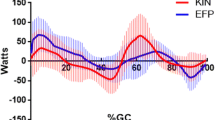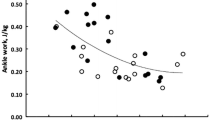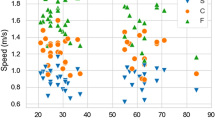Abstract
Age-related increased hip extensor recruitment during gait is a proposed compensation strategy for reduced ankle power generation and may indicate a distal-to-proximal shift in muscle function with age. Extending beyond joint level analyses, identifying age-related changes at the muscle level could capture more closely the underlying mechanisms responsible for movement. The purpose of this study was to characterize and compare muscle forces and induced accelerations during gait in healthy older adults with those of young adults. Simulations of one gait cycle for ten older (73.9 ± 5.3 years) and six young (21.0 ± 2.1 years) adults walking at their self-selected speed were analyzed. Muscle force and induced acceleration waveforms, along with kinematic, kinetic, and muscle activation waveforms, were compared between age-groups using principal component analysis. Simulations of healthy older adults had greater gluteus maximus force and vertical support contribution, but smaller iliacus force, psoas force, and psoas vertical support contribution. There were no age-group differences in distal muscle force, contribution, or ankle torque magnitudes. Later peak dorsiflexion and peak ankle angular velocity in older adults may have contributed to their greater ankle power absorption during stance. These findings reveal the complex interplay between age-related changes in neuromuscular control, kinematics, and muscle function during gait.






Similar content being viewed by others
References
Allet, L., H. IJzerman, K. Meijer, P. Willems, and H. Savelberg. The influence of stride-length on plantar foot-pressures and joint moments. Gait Posture 34:300–306, 2011.
Anderson, F. C., and M. G. Pandy. Individual muscle contributions to support in normal walking. Gait & Posture 17:159–169, 2003.
Andriacchi, T. P., E. J. Alexander, M. K. Toney, C. Dyrby, and J. Sum. A point cluster method for in vivo motion analysis: applied to a study of knee kinematics. J Biomech Eng 120:743–749, 1998.
Arnold, E. M., S. R. Ward, R. L. Lieber, and S. L. Delp. A model of the lower limb for analysis of human movement. Ann Biomed Eng 38:269–279, 2010.
Bureau U.S.C. 65+ in the United States: 2010. 2014, pp. 23–212.
Cappozzo, A., F. Catani, U. D. Croce, and A. Leardini. Position and orientation in space of bones during movement: anatomical frame definition and determination. Clin Biomech 10:171–178, 1995.
Crowninshield, R. D., and R. A. Brand. A physiologically based criterion of muscle force prediction in locomotion. J Biomech (Bristol, Avon) 14:793–801, 1981.
Delp, S. L., F. C. Anderson, A. S. Arnold, P. Loan, A. Habib, C. T. John, E. Guendelman, and D. G. Thelen. OpenSim: open-source software to create and analyze dynamic simulations of movement. IEEE Trans Biomed Eng 54:1940–1950, 2007.
Deluzio, K. J., U. P. Wyss, B. Zee, P. A. Costigan, and C. Sorbie. Principal component models of knee kinematics and kinetics: normal vs. pathological gait patterns. Hum Mov Sci 16:201–217, 1997.
DeVita, P., and T. Hortobagyi. Age causes a redistribution of joint torques and powers during gait. J Appl Physiol 88:1804–1811, 2000.
Hicks, J. L., OpenSim User’s Guide, 2016, 2012.
Hubley-Kozey, C. L., K. J. Deluzio, S. C. Landry, J. S. McNutt, and W. D. Stanish. Neuromuscular alterations during walking in persons with moderate knee osteoarthritis. J Electromyogr Kinesiol 16:365–378, 2006.
Jones, M. C., and J. A. Rice. Displaying the important features of large collections of similar curves. Am Stat 46:140–145, 1992.
Judge, J. O., R. B. Davis, 3rd, and S. Ounpuu. Step length reductions in advanced age: the role of ankle and hip kinetics. J Gerontol A Biol Sci Med Sci 51:M303–M312, 1996.
Kepple, T. M., K. L. Siegel, and S. J. Stanhope. Relative contributions of the lower extremity joint moments to forward progression and support during gait. Gait Posture 6:1–8, 1997.
Kerrigan, D. C., M. K. Todd, U. Della Croce, L. A. Lipsitz, and J. J. Collins. Biomechanical gait alterations independent of speed in the healthy elderly: evidence for specific limiting impairments. Arch Phys Med Rehabil 79:317–322, 1998.
Lajoie, Y., N. Teasdale, C. Bard, and M. Fleury. Upright standing and gait: are there changes in attentional requirements related to normal aging? Exp Aging Res 22:185–198, 1996.
Landry, S. C., K. A. McKean, C. L. Hubley-Kozey, W. D. Stanish, and K. J. Deluzio. Knee biomechanics of moderate OA patients measured during gait at a self-selected and fast walking speed. J Biomech 40:1754–1761, 2007.
Lim, Y. P., Y. C. Lin, and M. G. Pandy. Muscle function during gait is invariant to age when walking speed is controlled. Gait Posture 38:253–259, 2013.
Liu, M. Q., F. C. Anderson, M. G. Pandy, and S. L. Delp. Muscles that support the body also modulate forward progression during walking. J Biomech 39:2623–2630, 2006.
McGibbon, C. A., and D. E. Krebs. Effects of age and functional limitation on leg joint power and work during stance phase of gait. J Rehabil Res Dev 36:173–182, 1999.
Monaco, V., L. A. Rinaldi, G. Macri, and S. Micera. During walking elders increase efforts at proximal joints and keep low kinetics at the ankle. Clin Biomech (Bristol, Avon) 24:493–498, 2009.
Neptune, R. R., S. A. Kautz, and F. E. Zajac. Contributions of the individual ankle plantar flexors to support, forward progression and swing initiation during walking. J Biomech 34:1387–1398, 2001.
Neptune, R. R., F. E. Zajac, and S. A. Kautz. Muscle force redistributes segmental power for body progression during walking. Gait Posture 19:194–205, 2004.
Pandy, M. G. Computer modeling and simulation of human movement. Annu Rev Biomed Eng 3:245–273, 2001.
Physical Activity Guidelines Advisory Committee. Physical Activity Guidelines Advisory Committee Report, 2008.
Reid, S. M., R. B. Graham, and P. A. Costigan. Differentiation of young and older adult stair climbing gait using principal component analysis. Gait Posture 31:197–203, 2010.
Riley, P. O., U. DellaCroce, and D. C. Kerrigan. Effect of age on lower extremity joint moment contributions to gait speed. Gait Posture 14:264–270, 2001.
Schmitz, A., A. Silder, B. Heiderscheit, J. Mahoney, and D. G. Thelen. Differences in lower-extremity muscular activation during walking between healthy older and young adults. J Electromyogr Kinesiol 19:1085–1091, 2009.
Schoenborn, C. A. and K. M. Heyman. Healthy Characteristics of Adults Aged 55 Years and Over: United States, 2004–2007. National Health Statistics Reports No. 16, 2009.
Seth, A., M. Sherman, J. A. Reinbolt, and S. L. Delp. OpenSim: a musculoskeletal modeling and simulation framework for in silico investigations and exchange, 2011 IUTAM symposium on human body dynamics: from multibody systems to. Biomechanics 2:212–232, 2011.
Silder, A., B. Heiderscheit, and D. G. Thelen. Active and passive contributions to joint kinetics during walking in older adults. Journal of Biomechanics 41:1520–1527, 2008.
Stewart, A. L., K. M. Mills, A. C. King, W. L. Haskell, D. Gillis, and P. L. Ritter. CHAMPS physical activity questionnaire for older adults: outcomes for interventions. Med Sci Sports Exerc 33:1126–1141, 2001.
Studenski, S. Mobility. In: Principles of geriatric medicine and gerontology, edited by W. R. Hazzard, J. P. Blass, J. B. Halter, J. G. Ouslander, and M. E. Tinetti. New York: McGraw-Hill, 2003, pp. 947–960.
Thompson, J. A., A. M. Chaudhari, L. C. Schmitt, T. M. Best, and R. A. Siston. Gluteus maximus and soleus compensate for simulated quadriceps atrophy and activation failure during walking. J Biomech 46:2165–2172, 2013.
van der Krogt, M. M., S. L. Delp, and M. H. Schwartz. How robust is human gait to muscle weakness? Gait Posture 36:113–119, 2012.
Winter, D. A., A. E. Patla, J. S. Frank, and S. E. Walt. Biomechanical walking pattern changes in the fit and healthy elderly. Phys Ther 70:340–347, 1990.
Acknowledgments
The authors would like to acknowledge Bryan Heiderscheit for his assistance with data collection. This research was supported by the National Institutes of Health (Grant No. AG24276). This material is also based upon work supported by the National Science Foundation Graduate Research Fellowship Program under Grant Nos. DGE-1343012 (SAS), DGE-0822215 (JAT), and DGE-0718123 (AS).
Conflict of interest
None of the authors have a conflict of interest regarding the contents of this manuscript.
Author information
Authors and Affiliations
Corresponding author
Additional information
Associate Editor Thurmon E. Lockhart oversaw the review of this article.
Electronic supplementary material
Below is the link to the electronic supplementary material.
Rights and permissions
About this article
Cite this article
Schloemer, S.A., Thompson, J.A., Silder, A. et al. Age-Related Differences in Gait Kinematics, Kinetics, and Muscle Function: A Principal Component Analysis. Ann Biomed Eng 45, 695–710 (2017). https://doi.org/10.1007/s10439-016-1713-4
Received:
Accepted:
Published:
Issue Date:
DOI: https://doi.org/10.1007/s10439-016-1713-4




